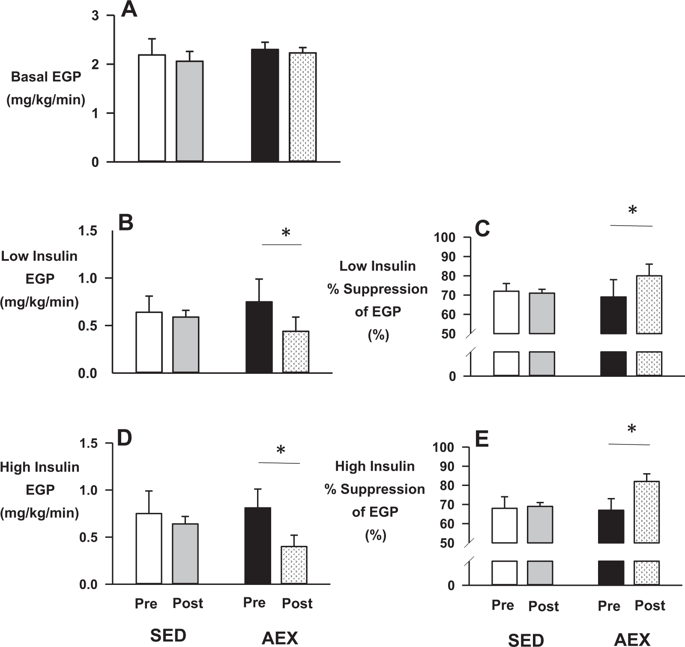当前位置:
X-MOL 学术
›
Nutr. Diabetes
›
论文详情
Our official English website, www.x-mol.net, welcomes your feedback! (Note: you will need to create a separate account there.)
Aerobic exercise training improves hepatic and muscle insulin sensitivity, but reduces splanchnic glucose uptake in obese humans with type 2 diabetes.
Nutrition & Diabetes ( IF 6.1 ) Pub Date : 2019-09-02 , DOI: 10.1038/s41387-019-0090-0 Justin M Gregory 1 , James A Muldowney 2 , Brian G Engelhardt 3 , Regina Tyree 4 , Pam Marks-Shulman 5 , Heidi J Silver 4 , E Patrick Donahue 6 , Dale S Edgerton 6 , Jason J Winnick 7
Nutrition & Diabetes ( IF 6.1 ) Pub Date : 2019-09-02 , DOI: 10.1038/s41387-019-0090-0 Justin M Gregory 1 , James A Muldowney 2 , Brian G Engelhardt 3 , Regina Tyree 4 , Pam Marks-Shulman 5 , Heidi J Silver 4 , E Patrick Donahue 6 , Dale S Edgerton 6 , Jason J Winnick 7
Affiliation

|
BACKGROUND
Aerobic exercise training is known to have beneficial effects on whole-body glucose metabolism in people with type 2 diabetes (T2D). The responses of the liver to such training are less well understood. The purpose of this study was to determine the effect of aerobic exercise training on splanchnic glucose uptake (SGU) and insulin-mediated suppression of endogenous glucose production (EGP) in obese subjects with T2D.
METHODS
Participants included 11 obese humans with T2D, who underwent 15 ± 2 weeks of aerobic exercise training (AEX; n = 6) or remained sedentary for 15 ± 1 weeks (SED; n = 5). After an initial screening visit, each subject underwent an oral glucose load clamp and an isoglycemic/two-step (20 and 40 mU/m2/min) hyperinsulinemic clamp (ISO-clamp) to assess SGU and insulin-mediated suppression of EGP, respectively. After the intervention period, both tests were repeated.
RESULTS
In AEX, the ability of insulin to suppress EGP was improved during both the low (69 ± 9 and 80 ± 6% suppression; pre-post, respectively; p < 0.05) and high (67 ± 6 and 82 ± 4% suppression, respectively; p < 0.05) insulin infusion periods. Despite markedly improved muscle insulin sensitivity, SGU was reduced in AEX after training (22.9 ± 3.3 and 9.1 ± 6.0 g pre-post in AEX, respectively; p < 0.05).
CONCLUSIONS
In obese T2D subjects, exercise training improves whole-body glucose metabolism, in part, by improving insulin-mediated suppression of EGP and enhancing muscle glucose uptake, which occur despite reduced SGU during an oral glucose challenge.
中文翻译:

有氧运动训练可以改善肝和肌肉对胰岛素的敏感性,但可以减少肥胖的2型糖尿病患者的内脏葡萄糖摄取。
背景技术已知有氧运动训练对2型糖尿病(T2D)患者的全身葡萄糖代谢具有有益的作用。肝脏对这种训练的反应知之甚少。这项研究的目的是确定有氧运动训练对肥胖的T2D患者的内脏葡萄糖摄取(SGU)和胰岛素介导的内源性葡萄糖生成(EGP)的抑制作用。方法参与者包括11位患有T2D的肥胖患者,他们接受了15±2周的有氧运动训练(AEX; n = 6);或者久坐不动15±1周(SED; n = 5)。初次筛查后,每个受试者均接受口服葡萄糖负荷钳和等血糖/两步法(20和40 mU / m2 / min)高胰岛素钳(ISO钳)分别评估SGU和胰岛素介导的EGP抑制。干预期过后,重复两次测试。结果在AEX中,在低(69±9和80±6%抑制;分别在事前或事后; p <0.05)和高(67±6和82±4%抑制)期间,胰岛素抑制EGP的能力均得到改善。分别; p <0.05)胰岛素输注期。尽管肌肉胰岛素敏感性显着改善,但训练后AGU的SGU降低(AEX事后分别为22.9±3.3和9.1±6.0 g; p <0.05)。结论在肥胖的T2D受试者中,运动训练部分通过改善胰岛素介导的EGP抑制和增强肌肉葡萄糖摄取来改善全身葡萄糖代谢,尽管口服葡萄糖激发期间SGU降低,但运动训练仍会发生。在低(69±9和80±6%抑制;分别在事前或事后; p <0.05)和高(分别为67±6和82±4%抑制)下,胰岛素抑制EGP的能力均得到改善。 <0.05)胰岛素输注时间。尽管肌肉胰岛素敏感性显着改善,但训练后AGU的SGU降低(AEX事后分别为22.9±3.3和9.1±6.0 g; p <0.05)。结论在肥胖的T2D受试者中,运动训练部分通过改善胰岛素介导的EGP抑制和增强肌肉葡萄糖摄取来改善全身葡萄糖代谢,尽管口服葡萄糖激发期间SGU降低,但运动训练仍会发生。在低(69±9和80±6%抑制;分别在事前或事后; p <0.05)和高(分别为67±6和82±4%抑制)下,胰岛素抑制EGP的能力均得到改善。 <0.05)胰岛素输注时间。尽管肌肉胰岛素敏感性显着改善,但训练后AGU的SGU降低(AEX事后分别为22.9±3.3和9.1±6.0 g; p <0.05)。结论在肥胖的T2D受试者中,运动训练部分通过改善胰岛素介导的EGP抑制和增强肌肉葡萄糖摄取来改善全身葡萄糖代谢,尽管口服葡萄糖激发期间SGU降低,但运动训练仍会发生。尽管肌肉胰岛素敏感性显着改善,但训练后AGU的SGU降低(AEX事后分别为22.9±3.3和9.1±6.0 g; p <0.05)。结论在肥胖的T2D受试者中,运动训练部分通过改善胰岛素介导的EGP抑制和增强肌肉葡萄糖摄取来改善全身葡萄糖代谢,尽管口服葡萄糖激发期间SGU降低,但运动训练仍会发生。尽管肌肉胰岛素敏感性显着改善,但训练后AGU的SGU降低(AEX事后分别为22.9±3.3和9.1±6.0 g; p <0.05)。结论在肥胖的T2D受试者中,运动训练部分通过改善胰岛素介导的EGP抑制和增强肌肉葡萄糖摄取来改善全身葡萄糖代谢,尽管口服葡萄糖激发期间SGU降低,但运动训练仍会发生。
更新日期:2019-09-02
中文翻译:

有氧运动训练可以改善肝和肌肉对胰岛素的敏感性,但可以减少肥胖的2型糖尿病患者的内脏葡萄糖摄取。
背景技术已知有氧运动训练对2型糖尿病(T2D)患者的全身葡萄糖代谢具有有益的作用。肝脏对这种训练的反应知之甚少。这项研究的目的是确定有氧运动训练对肥胖的T2D患者的内脏葡萄糖摄取(SGU)和胰岛素介导的内源性葡萄糖生成(EGP)的抑制作用。方法参与者包括11位患有T2D的肥胖患者,他们接受了15±2周的有氧运动训练(AEX; n = 6);或者久坐不动15±1周(SED; n = 5)。初次筛查后,每个受试者均接受口服葡萄糖负荷钳和等血糖/两步法(20和40 mU / m2 / min)高胰岛素钳(ISO钳)分别评估SGU和胰岛素介导的EGP抑制。干预期过后,重复两次测试。结果在AEX中,在低(69±9和80±6%抑制;分别在事前或事后; p <0.05)和高(67±6和82±4%抑制)期间,胰岛素抑制EGP的能力均得到改善。分别; p <0.05)胰岛素输注期。尽管肌肉胰岛素敏感性显着改善,但训练后AGU的SGU降低(AEX事后分别为22.9±3.3和9.1±6.0 g; p <0.05)。结论在肥胖的T2D受试者中,运动训练部分通过改善胰岛素介导的EGP抑制和增强肌肉葡萄糖摄取来改善全身葡萄糖代谢,尽管口服葡萄糖激发期间SGU降低,但运动训练仍会发生。在低(69±9和80±6%抑制;分别在事前或事后; p <0.05)和高(分别为67±6和82±4%抑制)下,胰岛素抑制EGP的能力均得到改善。 <0.05)胰岛素输注时间。尽管肌肉胰岛素敏感性显着改善,但训练后AGU的SGU降低(AEX事后分别为22.9±3.3和9.1±6.0 g; p <0.05)。结论在肥胖的T2D受试者中,运动训练部分通过改善胰岛素介导的EGP抑制和增强肌肉葡萄糖摄取来改善全身葡萄糖代谢,尽管口服葡萄糖激发期间SGU降低,但运动训练仍会发生。在低(69±9和80±6%抑制;分别在事前或事后; p <0.05)和高(分别为67±6和82±4%抑制)下,胰岛素抑制EGP的能力均得到改善。 <0.05)胰岛素输注时间。尽管肌肉胰岛素敏感性显着改善,但训练后AGU的SGU降低(AEX事后分别为22.9±3.3和9.1±6.0 g; p <0.05)。结论在肥胖的T2D受试者中,运动训练部分通过改善胰岛素介导的EGP抑制和增强肌肉葡萄糖摄取来改善全身葡萄糖代谢,尽管口服葡萄糖激发期间SGU降低,但运动训练仍会发生。尽管肌肉胰岛素敏感性显着改善,但训练后AGU的SGU降低(AEX事后分别为22.9±3.3和9.1±6.0 g; p <0.05)。结论在肥胖的T2D受试者中,运动训练部分通过改善胰岛素介导的EGP抑制和增强肌肉葡萄糖摄取来改善全身葡萄糖代谢,尽管口服葡萄糖激发期间SGU降低,但运动训练仍会发生。尽管肌肉胰岛素敏感性显着改善,但训练后AGU的SGU降低(AEX事后分别为22.9±3.3和9.1±6.0 g; p <0.05)。结论在肥胖的T2D受试者中,运动训练部分通过改善胰岛素介导的EGP抑制和增强肌肉葡萄糖摄取来改善全身葡萄糖代谢,尽管口服葡萄糖激发期间SGU降低,但运动训练仍会发生。



























 京公网安备 11010802027423号
京公网安备 11010802027423号